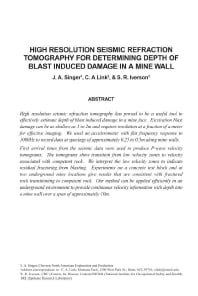Mining Publication: High Resolution Seismic Refraction Tomography for Determining Depth of Blast Induced Damage in a Mine Wall
Original creation date: August 2009
Authors: JA Singer, CA Link, SR Iverson
High resolution seismic refraction tomography has proved to be a useful tool to effectively estimate depth of blast induced damage in a mine face. Excavation blast damage can be as shallow as 1 to 2 m and requires resolution at a fraction of a meter for effective imaging. In this study, an accelerometer was used with flat frequency response to 1,000 Hz to record data at spacings of approximately 0.25 to 0.5 m along mine walls. First arrival times from the seismic data were used to produce P-wave velocity tomograms. The tomograms show transition from low velocity zones to velocity associated with competent rock. The low velocity zones were interpreted to indicate residual fracturing from blasting. Experiments on a concrete test block and at two underground mine locations give results that are consistent with fractured rock transitioning to competent rock. This method can be applied efficiently in an underground environment to provide continuous velocity information with depth into a mine wall over a span of approximately 10 m.

- Blast Wave Propagation in Underground Mines
- A Century of Bureau of Mines/NIOSH Explosives Research
- Development of an Automated PC-Network-Based Seismic Monitoring System
- Fatal Accidents Due to Flyrock and Lack of Blast Area Security and Working Practices in Mining
- A Gas Pressure-Based Drift Round Blast Design Methodology
- Low Temperature Limits for Mixing Recycled Oil, Diesel Fuel, and Ammonium Nitrate to Make ANFO-Type Blasting Agents
- Safe Distances for Blasting Wiring from Commonly Encountered Underground Electromagnetic Energy Sources
- A Summary of Fatal Accidents Due to Flyrock and Lack of Blast Area Security in Surface Mining, 1989 to 1999
- Technology News 522 - Blast Area Security: Flyrock Safety
- Toolbox Training on Flyrock Awareness